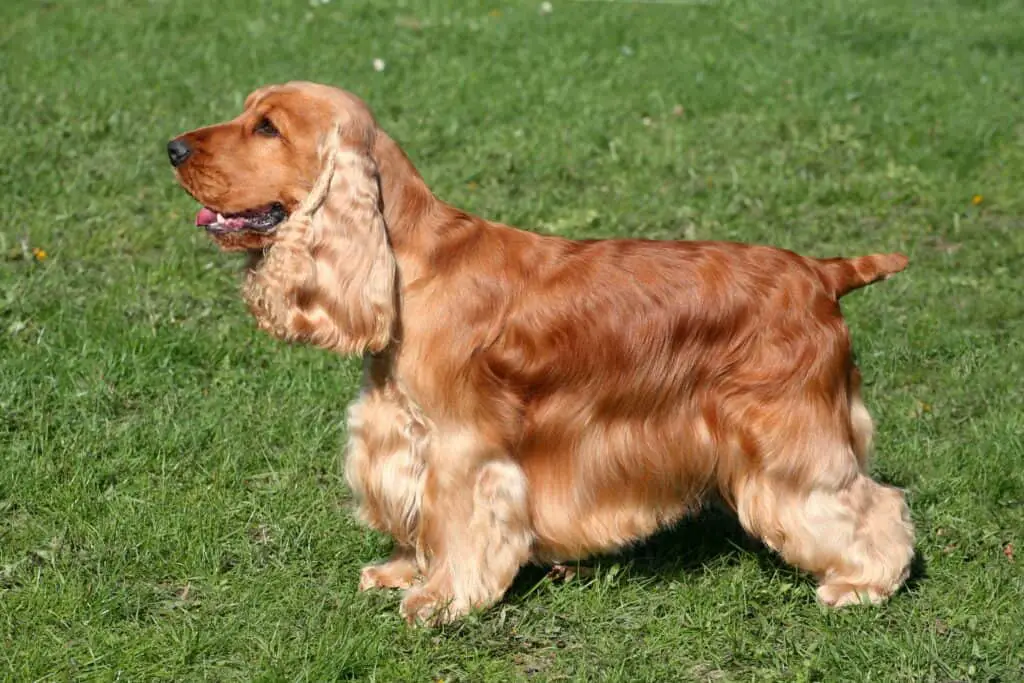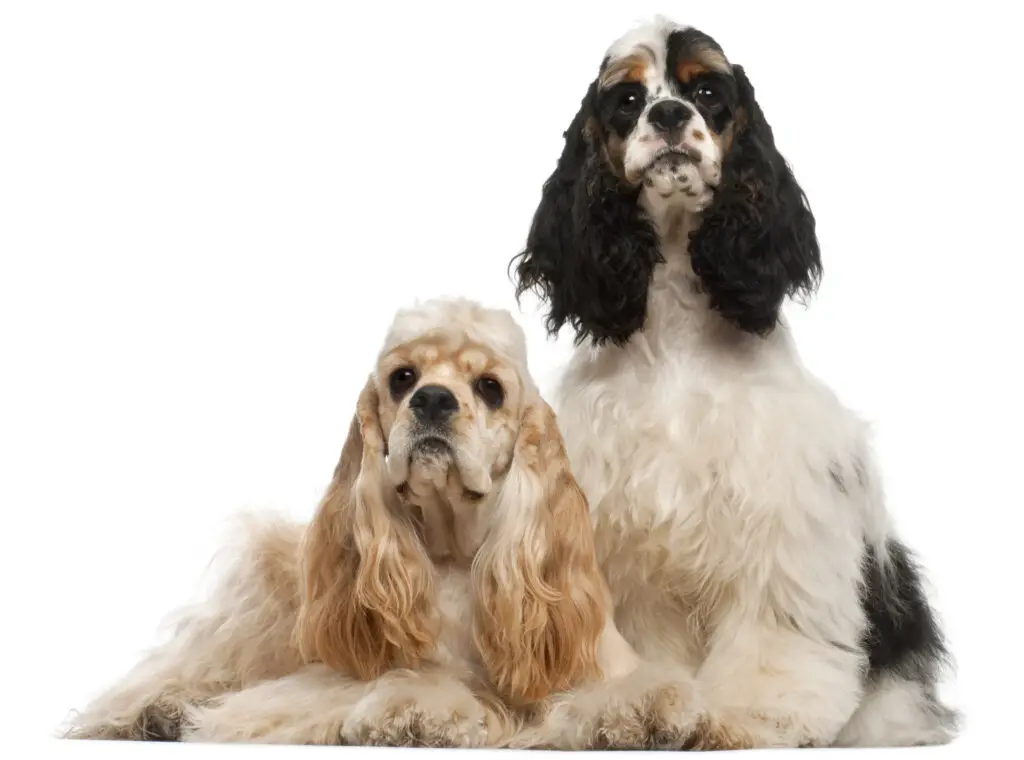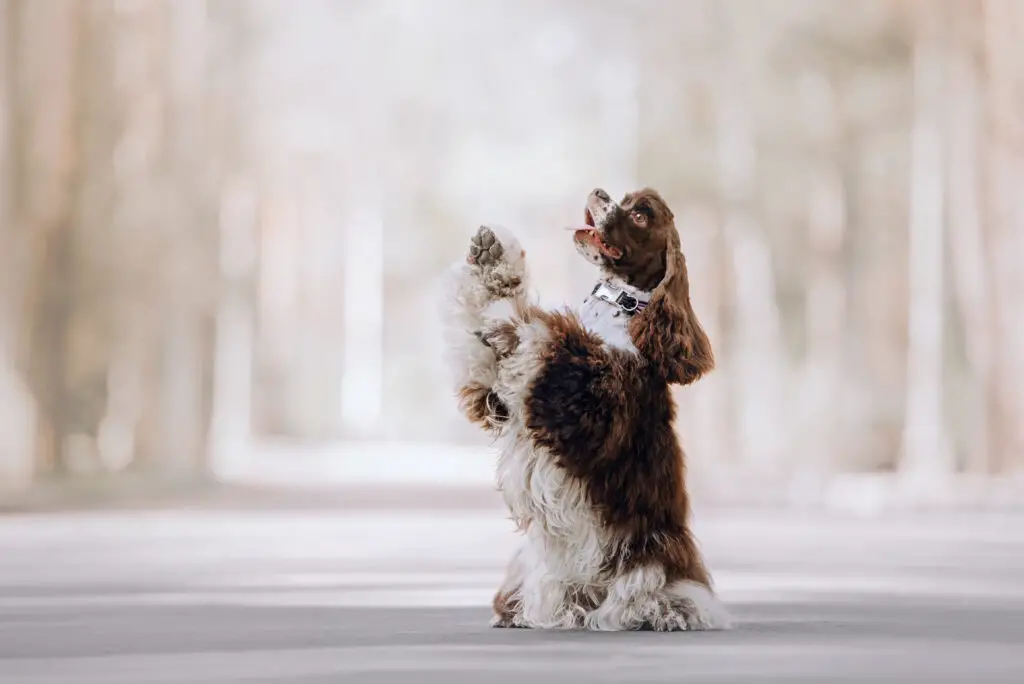Our website is supported by our users. We sometimes earn money when you click an affiliate link and make a purchase. This is at no extra cost to you and helps us to create quality content. Thank you for your support. For all that have shown us such wonderful support, we thank you from the bottom of our hearts!
If you are considering getting a dog, the Cocker Spaniel is a breed that you might want to consider.
These dogs are known for their friendly and loving personalities, making them great pets for families.
They are also highly trainable and can excel in obedience and agility competitions.

Cockers are a small to medium-sized breed, with an average height of 14 to 15 inches and a weight of 17 to 30 pounds.
They have a luxurious, silky, and long coat that comes in a variety of colors, including black, brown, red, and cream.
While their coats require regular grooming to keep them looking their best, they shed very little and are considered hypoallergenic.
In addition to being great family pets, Cocker Spaniels are also excellent hunting dogs.
They were originally bred for hunting birds, and their keen sense of smell and ability to work in dense cover make them well-suited for this task.
Whether you are looking for a loyal companion or a hunting partner, the Cocker Spaniel is a breed that you should definitely consider.
History of the Cocker Spaniel
The Cocker Spaniel is a breed of dog that has a rich history. Spaniels may have arrived in England during Caesar’s invasion, and it is assumed that they originated from
Spain as the word “spaniel” may be derived from “Hispania” or possibly from the French phrase “Chiens de l’Espagnol” (Dog of Spain).
The breed was originally developed as a hunting dog in the UK, specifically to hunt the Eurasian woodcock. The term “cocker” derives from their use in hunting this bird.
In the 19th century, the breed was brought to the United States, where it was further developed and bred to a different standard, which enabled it to specialize in hunting the American woodcock.


The American Cocker Spaniel and the English Cocker Spaniel were originally considered to be the same breed, but over time they were recognized as separate breeds due to their different standards and subtle differences.
The American Cocker Spaniel is smaller and has a shorter snout than the English Cocker Spaniel.
The Cocker Spaniel has been a popular breed for many years and has won numerous awards at dog shows such as the Westminster Kennel Club Dog Show and Crufts.
The breed is known for its friendly and affectionate nature, making it a popular choice as a family pet.
Cockers are also similar to other breeds such as Springer Spaniels and Labradors, which are also popular hunting dogs.
Despite their similarities, each breed has its own unique characteristics and strengths.
In conclusion, the Cocker Spaniel has a long and rich history as a hunting dog and family pet.
The breed has evolved over time, with the American Cocker Spaniel and the English Cocker Spaniel recognized as separate breeds.
The Cocker Spaniel remains a popular choice for those looking for a friendly and affectionate companion.
Physical Characteristics of the Cocker Spaniel

The Cocker Spaniel is a breed of dog that is known for its charming appearance and friendly personality.
They are smaller than their English counterparts and are the smallest of the sporting dogs.
The breed is sturdy and well-proportioned, with a short, square muzzle and long, floppy ears.
They have a silky, flat, and luxurious coat that comes in several colors, including liver, red, brown, and black.
The height of the Cocker Spaniel can range from 13 to 15 inches tall at the shoulder for both males and females.
The weight of the breed can also vary, with males weighing between 24-28 pounds and females weighing between 20-25 pounds.
American Cockers, which are a close cousin of the Cocker Spaniel, are a small sporting dog breed from the United States. It has a long, silky coat, big, expressive brown eyes, and long, furry ears.
With proper care and attention, a Cocker Spaniel can live a long and healthy life, with a lifespan of around 12-15 years.
The breed is typically just referred to as the Cocker Spaniel in the US, but outside of the US, it is known as the American Cocker Spaniel to differentiate it from its English counterpart.
Cockers are known for their friendly and outgoing personalities.
They are intelligent, easy to train, and make great family pets.
Their popularity soared after World War II, and in 1984, Cockers were the number one breed registered with the American Kennel Club.
They even have their own breed club: The American Spaniel Club (ASC) is the parent club for the Cocker Spaniel and the primary guardian of the Cocker Spaniel breed
Temperament & Training of the Cocker Spaniel
The Cocker Spaniel is a friendly, gentle, and intelligent sporting breed.
They have a medium to high energy level and have a sweet temperament that makes them excellent with kids, and a popular choice for families.
However, they can be prone to barking, so early obedience training is essential.
Cockers are known for their playful personalities and love to be around people.
They are affectionate and loyal to their owners, and they thrive on attention and affection.
They are also highly trainable and respond well to positive reinforcement techniques.
When it comes to proper training for good manners, it’s important to start early and be consistent. Cockers are intelligent dogs, but they can be stubborn at times.
Obedience training can help to establish boundaries and prevent unwanted behaviors such as excessive barking or jumping.
In addition to obedience dog training, Cockers also benefit from socialization. Exposing them to different people, places, and experiences can help to reduce anxiety and prevent aggression and to be a good citizen.
It’s important to introduce them to other dogs and animals early on to prevent any potential behavioral issues.
Remember, they are bred for hunting birds so they have a deep hunting instinct and may stalk birds, bunnies and squirrels in your yard.
Overall, the Cocker Spaniel is a friendly and intelligent breed that makes an excellent companion for families.
With early training and socialization, they can be well-behaved and obedient pets that bring joy and happiness to their owners.
Health Issues of the Cocker Spaniel
As with any breed, Cockers are prone to certain health issues that you should be aware of if you are considering getting one as a pet.
Here are some of the most common health problems that can affect Cockers:
Ear Infections
Cockers are known for their long, floppy ears, which can trap moisture and bacteria and lead to ear infections in their ear canals.
Signs of an ear infection include redness, swelling, and a foul odor coming from the ear.
If you notice these signs, take your dog to the vet for treatment.
Some dogs develop chronic ear infections.
Be sure to clean your Spaniel’s ears regularly with the medicated ear wash given by your veterinarian.
Progressive Retinal Atrophy
Progressive Retinal Atrophy (PRA) is a hereditary eye disorder that affects Cockers.
This condition involves the gradual degeneration of the retina, leading to progressive vision loss and, in some cases, total blindness.
PRA typically manifests in older dogs, and affected Cockers may initially show signs of night blindness, followed by a gradual reduction in daytime vision.
Genetic factors play a significant role in PRA, and responsible breeding practices, including genetic testing, can help reduce the prevalence of this condition.
While there is no cure for PRA, supportive measures such as providing a consistent environment and minimizing environmental changes can help affected Cockers adapt to their vision loss.
Regular veterinary check-ups and monitoring for early signs of PRA can aid in timely management and ensure the well-being of these beloved companions.
Eye Problems
Cockers are also prone to various eye problems, including cataracts, glaucoma, and cherry eye.
These conditions can cause vision loss and discomfort for your dog.
Regular check-ups with an eye specialist can help catch these issues early and prevent them from worsening.
Hip Dysplasia
Hip dysplasia is a genetic condition that affects many dog breeds, including the Cocker Spaniel.
It occurs when the hip joint doesn’t develop properly, leading to arthritis and pain.
Overweight dogs and those who don’t get enough exercise are at a higher risk of developing hip dysplasia.
Patellar Luxation
Patellar luxation is another genetic condition that can affect Cocker Spaniels.
It occurs when the kneecap slides out of place, causing pain and difficulty walking.
Surgery may be necessary to correct this issue.
Obesity
Cockers are prone to obesity, which can lead to a variety of health problems, including diabetes, heart disease, and joint pain.
Make sure to feed your dog a healthy diet and provide plenty of exercise to keep them at a healthy weight.
In conclusion, while Cockers are generally healthy dogs, they are prone to certain health issues that you should be aware of if you are considering getting one as a pet.
Regular check-ups with your vet and proper care can help prevent and manage these issues, ensuring a happy and healthy life for your furry friend.
Grooming Your Cocker Spaniel
Cocker Spaniels are known for their beautiful, silky coat, but grooming them can be a challenge.
With their long hair and tendency to get mats and tangles, regular grooming is essential to keep them looking and feeling their best.
We must stress again that grooming a Cocker Spaniel is a very time consuming job and requires effort in order to keep matts, tangles and debris out of their fur.
Here are some tips on how to groom your Cocker Spaniel and keep their coat healthy and shiny.
Brushing
Brushing your Cocker Spaniel’s coat is one of the most important grooming tasks you can do. It helps to remove tangles and mats, distribute natural oils, and keep the coat looking shiny and healthy.
Use a slicker brush or a pin brush to gently brush your dog’s coat, starting at the head and working your way down to the tail.
Be sure to brush all the way down to the skin but be gentle to avoid hurting your dog.
Don’t forget your dog’s curly, lush ears. They can get tangles too.
Surprisingly, even the fur between their paw pads can mat and collect debris.
Rocks, sharp pine needles and even compacted snowballs can get caught and become quite painful.
Therefore, it is important to keep the fur trimmed between their paw pads.
For the winter, in order for their feet to not get chapped and to repel snow, we used Musher’s Wax. It’s pricey but it goes a long way.
Bathing
Bathing your Cocker Spaniel is also an important part of their grooming routine.
Use a high-quality dog shampoo and conditioner and be sure to rinse thoroughly to avoid leaving any residue on your dog’s coat.
If your dog has sensitive skin, you may want to use a hypoallergenic shampoo.
Be careful not to get water in your dog’s ears and be sure to dry them thoroughly after the bath.

Cutting Fur/Hair
Cockers have long hair that can easily get tangled and matted.
Regular trimming can help to prevent this and keep your dog’s coat looking neat and tidy.
You can either take your dog to a professional groomer or do it yourself at home.
If you’re doing it yourself, be sure to use sharp scissors and go slowly to avoid cutting your dog’s skin.
We had great success with these clippers oneisall Dog Shaver Clippers Low Noise Rechargeable Cordless Electric Quiet Hair Clippers.
Clipping or Grinding Nails
Keeping your Cocker Spaniel’s nails trimmed is important for their health and comfort.
Long nails can cause discomfort and even pain when your dog walks.
You can use clippers or a grinder to trim your dog’s nails, but be careful not to cut the quick (the blood vessel inside the nail).
If you’re not comfortable doing it yourself, you can take your dog to a professional groomer or veterinarian.
Or you can look at our articles: How to Grind Your Dog’s Nails Safely and How to Clip a Dog’s Nails Safely.
Dental Care
Dental care is often overlooked when it comes to grooming, but it’s an important part of your Cocker Spaniel’s overall health.
Brush your dog’s teeth regularly with a dog toothbrush and toothpaste or use dental chews or toys to help keep their teeth clean.
Regular dental checkups with your veterinarian are also important to catch any dental problems early.
Cleaning Ears
Cockers are prone to ear infections, so it’s important to keep their ears clean and dry.
Use a cotton ball or soft cloth to gently clean your dog’s ears and be sure to dry them thoroughly after bathing or swimming.
These Pet MD Dog Ear Cleaner Wipes are compact and portable which makes them convenient to take them anywhere.
If you notice any signs of an ear infection, such as redness, swelling, or discharge, contact your veterinarian right away.
With regular brushing, bathing, trimming, and nail clipping, you can help your dog look and feel their best.
Remember to always be gentle and patient and seek professional help if you’re not comfortable doing any of these tasks yourself.
Owning a Cocker Spaniel
If you’re considering getting a Cocker Spaniel, there are a few things you should know before making your decision.
Here are some important factors to consider when owning a Cocker Spaniel.
Cost of Purchase
The average cost of purchasing a Cocker Spaniel from a breeder is around $1,000 to $2,000.
However, prices can vary depending on the breeder and location.
Adopting a Cocker Spaniel from a shelter or rescue organization is usually less expensive, with adoption fees ranging from $100 to $300.
Our Cleo, a purebred Cocker, was adopted from a local shelter.
Her young owner was a soldier that deployed overseas. Being a young and energetic dog, she was too much for the owner’s grandmother to handle so she surrendered Cleo to the local shelter.
My dad got her and she was around a year old. But she wasn’t abused or abandoned cruelly.
It was just a bad circumstance for the former her owner but a delightful one for my dad.
Maintenance Costs
Cocker Spaniels require regular grooming to keep their coats healthy and clean.
This includes brushing their fur daily and taking them to a professional groomer every 4-6 weeks.
In addition, Cockers are prone to ear infections, so their ears should be cleaned regularly. The cost of grooming and veterinary care can add up, so it’s important to budget accordingly.

Adopting a Cocker Spaniel
Adopting a Cocker Spaniel can be a great option for those who want to provide a loving home for a dog in need.
There are many rescue organizations that specialize in Cockers, and you can often find them at local animal shelters as well.
When adopting, it’s important to do your research and find a reputable organization that screens their dogs for health and temperament issues.
As mentioned, our Cocker Spaniel was adopted from a local shelter at about a year old and died at 17 years old. She was a wonderful dog.
Finding Breeders
If you decide to purchase a Cocker Spaniel from a breeder, it’s important for prospective owners to find a reputable dog breeders who prioritizes the health and well-being of their dogs.
The American Kennel Club (AKC) is a good resource for finding reputable breeders in your area.
Be sure to ask the breeder about the health and temperament of the parents and ask to see health clearances for common Cocker Spaniel health issues such as hip dysplasia and eye problems.
If you are spending the time to find the right breeder and paying for a purebred dog, you want to get the right puppy.
Fun Facts
- Cockers were originally bred as hunting dogs, specifically to retrieve game birds.
- The Cocker Spaniel is one of the most popular dog breeds in the United States, ranking 30th out of 197 breeds recognized by the AKC.
- The American Cocker Spaniel and the English Cocker Spaniel are two separate breeds, with different physical attributes and temperaments.
- Cockers were popularized in the 1955 Disney movie “Lady and the Tramp.”
- President Richard Nixon owned a Cocker Spaniel named Checkers.
Overall, Cockers make great family pets and companions. They are good with children and other pets, and their friendly and affectionate nature makes them popular among dog lovers.
Frequently Asked Questions
What is the average size and weight of a Cocker Spaniel?
Cockers are a medium-sized breed of dog. According to the American Kennel Club (AKC), they typically stand about 14 to 15 inches tall and weigh between 20 to 30 pounds.
What is the temperament of a Cocker Spaniel?
Cockers are known for their friendly and affectionate nature.
They make great family pets and are good with children.
They are also intelligent and trainable but can be sensitive and require positive reinforcement training methods.
Where can I find Cocker Spaniel puppies for sale?
It is important to find a responsible breeder when looking for a Cocker Spaniel puppy.
You can start by checking with the AKC or breed-specific rescue organizations.
Avoid purchasing puppies from pet stores or online sellers, as they may come from puppy mills or backyard breeders.
What is a Working Cocker Spaniel?
A Working Cocker Spaniel is a type of Cocker Spaniel that is bred for hunting and retrieving game.
They are typically smaller and more agile than show-bred Cocker Spaniels and have a higher energy level. They require plenty of exercise and mental stimulation.
How much does a Cocker Spaniel typically weigh?
As mentioned earlier, Cockers typically weigh between 20 to 30 pounds.
However, it is important to note that weight can vary depending on factors such as age, gender, and activity level.
What are some popular Cocker Spaniel mixes?
Some popular Cocker Spaniel mixes include the Cocker-Poo (Cocker Spaniel and Poodle),
Cockalier (Cocker Spaniel and Cavalier King Charles Spaniel), and the Cocker Spaniel and Beagle mix.
It is important to research the specific breed mix and understand the potential health and temperament issues before adopting.
Bottom Line on the Cocker Spaniel

In conclusion, Cocker Spaniels are a great choice for those looking for a loyal and affectionate companion.
They are highly intelligent and can easily learn new commands, making them a great choice for first-time dog owners. However, it’s important to note that they require a lot of exercise and attention to keep them happy and healthy.
When it comes to grooming, Cocker Spaniels require regular brushing and grooming to keep their long, silky coat free of tangles and mats.
They are prone to ear infections due to their floppy ears, so it’s important to keep their ears clean and dry.
Overall, Cocker Spaniels are a wonderful breed of dog that can bring a lot of joy and love into your life. With proper care and attention, they can make a great addition to any family.
Please read our Legal Disclaimer







